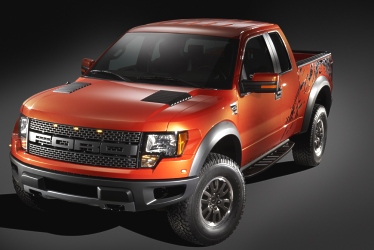|
August 20, 2009
This Week:
© 1998 - 2009
Copyright &
Disclaimer
Automotive Intelligence,
www.autointell.com
All Rights Reserved .
For questions please contact
editor@autointell.net
|
|
Ford’s new 2010 SVT Raptor ready for the
off-road extreme
|

2010 Ford SVT Raptor |
-
The 2010 Ford F-150 SVT Raptor launches with the proven
three-valve Triton 5.4-liter V-8 engine delivering 320
horsepower and 390 ft.-lb. of torque; a new 6.2-liter engine
with an estimated 400 horsepower and 400 ft.-lb. of torque
becomes available shortly after launch
-
Both engines underwent extreme laboratory testing, including
running the engines at over 6,000 rpm for more than 150
hours
-
The engines also were put to the test in the desert on a
62-mile evaluation loop to prove out the durability demanded
by high-performance, off-road enthusiasts
Mike Harrison’s enthusiasm for V-8
engines is apparent. Harrison, Ford Motor Company’s premium V-8
systems manager, is particularly excited about the availability
of the new 6.2-liter V-8 that will power the Ford F-150 SVT
Raptor.
|
|
|
|
Producing an estimated 400 horsepower and
400 ft.-lb. of torque, Harrison rattles off the new engine’s components and
features quickly and easily, pointing them out and explaining them with more
than a trace of pride.
Harrison wants that engine to perform to
its maximum capabilities so that customers of the F-150 SVT Raptor won’t have
anything to worry about. In short, if the engine can withstand the rigorous
testing Ford demands during the development cycle, it can withstand almost
anything the most enthusiastic off-roader can dish out, even desert racers.
The testing is intense. It’s cruel, dusty
and dirty. By working in the lab to push the engine to its limits, the process
simulates how a customer would use the engine. But then it goes a little bit
further.
|
“Running it over 6,000 rpm for more
than 150 hours, which is over the peak power limit of the
engine, really puts it through its paces,” Harrison said. “We’ve
tested it in harsher operating conditions on the engine dyno
than would ever be seen by a customer who races.”


Beginning in fall 2006, Harrison and his team
tested more than 50 engines, with each running through a dozen separate
tests. Evaluations included high-speed durability, crank-torsional
testing, aeration and a thermal cycle where the engine is “shocked” from
one temperature extreme to another.
As with all Ford programs, attention to detail
was a hallmark of the testing process.
|
 |
“We did a careful teardown of each
engine at completion of testing to ensure there absolutely are
no issues with the hardware,” Harrison said. “These are very
demanding, very stringent tests – far more stringent than
anything you would see on a truck – racing or otherwise.”
Testing in the heat Besides dyno
testing, the engine was put to the test in its element – the
desert of Borrego Springs, Calif. Important factors such as
engine cooling were evaluated on the 62-mile test loop designed
by Ford’s Special Vehicle Team (SVT).
Engine cooling is key on Raptor – when
the truck is in a desert environment, the hot weather and deep
sand put a heavy load on the vehicle, and the engine has to
exert maximum power to keep it going through deep sand.
There also is less airflow through the
radiator at low speeds, and a large and effective cooling system
is required for this extreme environment. To improve airflow to
the engine, grille openings were increased by 20 percent. |
“We spent a lot of time developing our desert
durability test so that it’s very close to replicating the Baja 1000,”
said Kerry Baldori, SVT chief functional engineer. “Desert testing
proved to be a very quick way to learn about the reliability of the
truck and it put another level of extreme loads on the engine that our
normal durability testing doesn’t cover.”
|
 |
Features of the new 6.2-liter V-8
engine include:
-
Cast-iron engine block and four-bolt main bearing caps, with
additional cross bolts, for durability
-
Aluminum cylinder heads, with two valves per cylinder head
and two spark plugs per cylinder to more efficiently burn
the fuel-air mixture in the combustion
-
Single overhead camshaft with roller-rocker shaft drivetrain,
which creates a stiff valvetrain that allows optimized
camshaft lift profiles and results in better low-speed
torque. The roller-rocker shafts allow valve angles to be
splayed, resulting in optimized intake and exhaust port
layout for better engine “breathing”
|
-
Dual-equal variable cam timing means intake
and exhaust valve opening and closing events are phased at the same
time to optimize fuel economy and performance throughout the engine
speed range and throttle positions Core to the improvements is using
a larger bore and shorter stroke. This approach to creating power
has its roots in storied Ford racing engines from the past. The
large bore (102 mm) allows for larger intake and exhaust valves for
improved engine breathing, and the shorter stroke (95 mm) allows
higher engine speed for increased horsepower. Still, peak horsepower
is generated at a relatively modest 5,500 rpm. Piston cooling jets
squirt oil on the underside of the pistons to keep the piston crowns
cool under extreme operating conditions.
Crankcase breathing is also improved to reduce
windage losses and oil aeration levels at very high speeds. “That really
helps get a robust lubrication system for the engine,” said Harrison.
“It allows us to endure a lot of time at extreme high speeds.”
The 2010 Ford F-150 SVT Raptor launches with
Ford’s proven three-valve Triton 5.4-liter V-8 engine. The new 6.2-liter
engine will become available in early 2010
(August 17, 09)
|

